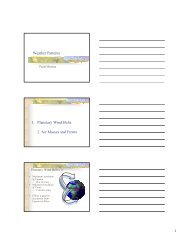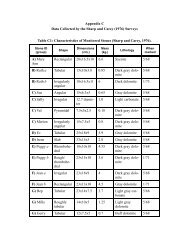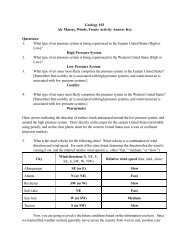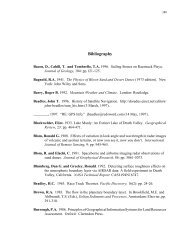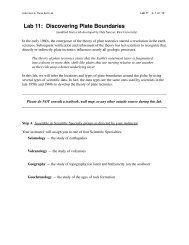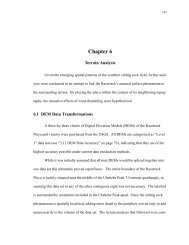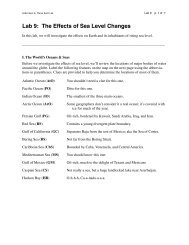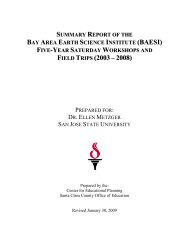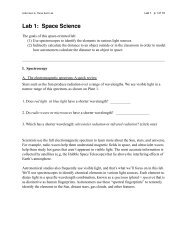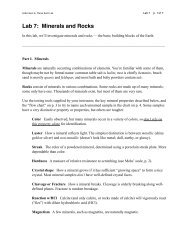Lab 7: Minerals and Rocks
Lab 7: Minerals and Rocks
Lab 7: Minerals and Rocks
You also want an ePaper? Increase the reach of your titles
YUMPU automatically turns print PDFs into web optimized ePapers that Google loves.
SJSU Geol 4L Planet Earth <strong>Lab</strong> <strong>Lab</strong> 7 p. 2 of 5Mohs’ Scale of Relative Hardness (“What scratches what?”)The hardness of a mineral can be tested by scratching. A mineral can only be scratched by aharder substance. A hard mineral can scratch a softer mineral, but a soft mineral can not scratch aharder mineral. Therefore, a relative scale can be established simply by seeing which mineralscratches another. The scale proposed by the French mineralogist Friedrich Mohs (in 1812) isstill used throughout the world. The higher the number, the harder the mineral.The list also includes several common items that can be used to help determine the relative hardnessof a mystery mineral.1 Talc2 Gypsum3 Calcite4 Fluorite5 Apatite~2.5: fingernail~3.5: copper penny~5.5: window glass or typical knife blade6 Orthoclase7 Quartz8 Topaz~6.5: streak plate or good steel file9 Corundum10 Diamond_____________________________________________________________________________FYI: The Mohs scale scale is relative, not absolute; fluorite (4) is not twice as hard as gypsum(2). Here’s the true relation among these ten minerals, setting talc as the baseline (= 1).1 Talc3 Gypsum9 Calcite21 Fluorite48 Apatite72 Orthoclase100 Quartz200 Topaz400 Corundum1600 Diamond
SJSU Geol 4L Planet Earth <strong>Lab</strong> <strong>Lab</strong> 7 p. 3 of 5Part II. <strong>Rocks</strong>In this part of the lab, we’ll examine examples of the most common igneous, sedimentary, <strong>and</strong>metamorphic rocks. Complete (in any order) each of the three stations located around the room.A. Igneous rocksIgneous rocks form when molten magma or lava cools (the ign- prefix means fire in Latin).When magma stays underground, it cools very slowly. The resulting rock consists of interlockingcrystals visible to the naked eye. These are plutonic rocks (after Pluto, god of the underworld).plutonic: underground; big crystalsWhen magma erupts on Earth’s surface, it cools quickly. The resulting rock consists mostly orcompletely of crystals that are too small to see. These are volcanic rocks (after volcanoes).volcanic: on Earth’s surface; few or no crystalsThe composition of igneous rocks also is important to geologists, but we’ll just use the followinginformal rule of thumb: Lighter-colored rocks have more silica (SiO2); darker-colored rocks haverelatively less.lighter: more SiO2 darker: less SiO2Look carefully at your samples of granite <strong>and</strong> rhyolite.1. Which is relatively coarser-grained? ____________________2a. Which cooled more quickly? ___________________ 2b. Why do you think so?Now look at the samples of gabbro, diorite, <strong>and</strong>esite, <strong>and</strong> basalt.3a. Which are plutonic? ________________________________ 3b. Why do you think so?4a. Which probably have the least SiO2? _______________________ 4b. Why do you think so?Some volcanic eruptions produce lava that cools so quickly that no crystals grow at all. Two examplesof these glassy-looking rocks are obsidian (be careful of its sharp edges) <strong>and</strong> pumice.5. Why do you think pumice has such a low density?
SJSU Geol 4L Planet Earth <strong>Lab</strong> <strong>Lab</strong> 7 p. 4 of 5B. Sedimentary rocksHistory of a typical sedimentary rock: (1) <strong>Rocks</strong> (of any type) are exposed at Earth’s surface <strong>and</strong>erode (broken down) into bits of s<strong>and</strong>, gravel, <strong>and</strong> mud—collectively known as sediment.(2) Sediment is transported downhill, usually by running water, <strong>and</strong> deposited in low-lying areaslike valleys, lakes, <strong>and</strong> oceans. Sediment is deposited in layers that geologists call beds.(3) Accumulated sediment turns into sedimentary rock when it compressed (by the overlyingsediments) <strong>and</strong> cemented together (by chemical precipitates from ocean water or groundwater).Examine the bowls of loose sediment, <strong>and</strong> the samples of s<strong>and</strong>stone <strong>and</strong> conglomerate.1. S<strong>and</strong> is to s<strong>and</strong>stone as ____________ is to conglomerate.2. How would you describe the difference(s) between the s<strong>and</strong>stone <strong>and</strong> conglomerate?3. In what way(s) are the s<strong>and</strong>stone <strong>and</strong> conglomerate similar (i.e., more similar to each otherthan to an igneous rock)?4. Some sedimentary rocks, such as limestone, contain fossils—the remains of ancient plants <strong>and</strong>critters. Find the samples with fossils. What types of fossils are present? (just use general, everydayterms).5. Find sample C6R-84-VIII. Estimate how much of this rock is composed of fossils: _______ %6. Sedimentary rocks also tell us about the environment in which the sediments accumulated.Find the sample labeled ripples. Based on what you know about where modern ripples can befound, where do you think the sediment in this rock may have been deposited?
SJSU Geol 4L Planet Earth <strong>Lab</strong> <strong>Lab</strong> 7 p. 5 of 5C. Metamorphic rocksMetamorphic rocks form when pressure, temperature, or corrosive fluids change the texture ormineral composition of any pre-existing rock (which could have been an igneous, a sedimentary,or even a different metamorphic rock). We will divide metamorphic rocks into two types:Foliated metamorphic rocks look streaked, sheeted, or b<strong>and</strong>ed. In a foliated rock, flatminerals are roughly parallel to one another due to tectonic squeezing of the rock.Unfoliated metamorphic rocks either weren’t squeezed very hard, or don’t haveenough flat minerals to show a foliation.Compare the samples of shale <strong>and</strong> slate. Shale, a sedimentary rock made of compacted mud, isdull, earthy, <strong>and</strong> comparatively lightweight. Slate, a metamorphic rock, is somewhat shiny, foliated,<strong>and</strong> denser. Don’t continue until you’re sure you can see these differences.1. Which of your metamorphic rock samples is foliated?a. slate? yes ! b. schist (“shist”)? ______! c. gneiss (“nice”)? ______!d. marble? ______ e. quartzite? ______ f. serpentinite? ______When metamorphism happens at high temperature<strong>and</strong> pressure, rocks may deform like soft plastic.Find the folded rock sample.2. Draw a picture in the space at the right showingthe direction of compressional force necessary toproduce the folding you see in this rock (experimentwith a sheet of paper).Find the serpentinite, which is California’s state rock. Serpentinite forms when corrosive fluidsmetamorphose the rocks of Earth’s mantle. Serpentinite is pretty rare, <strong>and</strong> most of it is found onthe ocean floor. Serpentinite followed a long, arduous trek to get from the ocean floor to the Californiahills where we found it, so please be nice to it.3. Why do you think serpentinite has that name? Before you answer this question, look at asmany serpentinite samples as possible.




